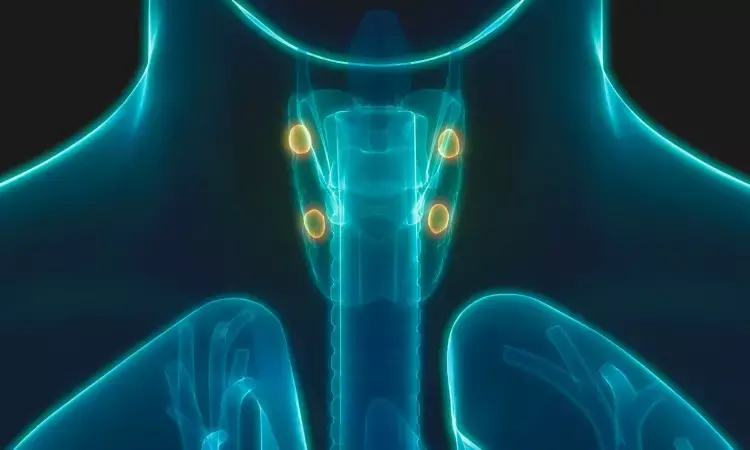- Home
- Medical news & Guidelines
- Anesthesiology
- Cardiology and CTVS
- Critical Care
- Dentistry
- Dermatology
- Diabetes and Endocrinology
- ENT
- Gastroenterology
- Medicine
- Nephrology
- Neurology
- Obstretics-Gynaecology
- Oncology
- Ophthalmology
- Orthopaedics
- Pediatrics-Neonatology
- Psychiatry
- Pulmonology
- Radiology
- Surgery
- Urology
- Laboratory Medicine
- Diet
- Nursing
- Paramedical
- Physiotherapy
- Health news
- Fact Check
- Bone Health Fact Check
- Brain Health Fact Check
- Cancer Related Fact Check
- Child Care Fact Check
- Dental and oral health fact check
- Diabetes and metabolic health fact check
- Diet and Nutrition Fact Check
- Eye and ENT Care Fact Check
- Fitness fact check
- Gut health fact check
- Heart health fact check
- Kidney health fact check
- Medical education fact check
- Men's health fact check
- Respiratory fact check
- Skin and hair care fact check
- Vaccine and Immunization fact check
- Women's health fact check
- AYUSH
- State News
- Andaman and Nicobar Islands
- Andhra Pradesh
- Arunachal Pradesh
- Assam
- Bihar
- Chandigarh
- Chattisgarh
- Dadra and Nagar Haveli
- Daman and Diu
- Delhi
- Goa
- Gujarat
- Haryana
- Himachal Pradesh
- Jammu & Kashmir
- Jharkhand
- Karnataka
- Kerala
- Ladakh
- Lakshadweep
- Madhya Pradesh
- Maharashtra
- Manipur
- Meghalaya
- Mizoram
- Nagaland
- Odisha
- Puducherry
- Punjab
- Rajasthan
- Sikkim
- Tamil Nadu
- Telangana
- Tripura
- Uttar Pradesh
- Uttrakhand
- West Bengal
- Medical Education
- Industry
Microwave and Radiofrequency Ablation Are Effective Alternatives to Surgery for Hyperparathyroidism in Seniors: Study

China: Researchers have found that in older adults with hyperparathyroidism, minimally invasive thermal ablation techniques-microwave ablation (MWA) and radiofrequency ablation (RFA)-are both safe and effective alternatives to traditional surgery.
The findings, published in Radiology on October 28, stem from a multicenter prospective trial involving 153 participants (mean age 63 years), which demonstrated high cure rates and minimal complications over a two-year follow-up.
Led by Dr. Luxin Zhang from the Department of Interventional Ultrasound, Medical School of the Chinese People’s Liberation Army, Beijing, the study emphasizes that these techniques could particularly benefit older or frail patients who face higher surgical risks. “The lower complication rates with MWA and RFA make them highly appealing options for elderly patients with contraindications for parathyroidectomy,” noted the researchers.
Hyperparathyroidism, whether primary (PHPT) or secondary (SHPT), is an endocrine disorder marked by excessive parathyroid hormone (PTH) production. Elevated PTH levels can lead to bone loss, fractures, and cardiovascular complications. While parathyroidectomy is the standard treatment, it carries risks such as postoperative respiratory and cardiovascular events—especially in older adults. Thermal ablation, on the other hand, is a minimally invasive, ultrasound-guided approach that can be performed under local anesthesia. It offers faster recovery, less trauma, and fewer complications, but evidence among older patients has been limited until now.
The researchers evaluated 153 patients aged 55 and above with PHPT or SHPT who underwent either MWA or RFA between 2017 and 2022.
The key findings of the study were as follows:
- The overall cure rate among patients with primary hyperparathyroidism was 80%, with similar outcomes for both techniques—78% for microwave ablation (MWA) and 86% for radiofrequency ablation (RFA) (p = 0.59).
- In cases of secondary hyperparathyroidism, the PTH achievement rate, defined as maintaining target PTH levels for at least six months, reached 90%, with no significant difference between MWA (92%) and RFA (87%) (p = 0.48).
- Both MWA and RFA led to significant reductions in serum PTH, calcium, and alkaline phosphatase (ALP) levels over a 24-month follow-up period.
- Preoperative PTH levels were identified as an independent predictor of treatment failure in both primary and secondary hyperparathyroidism.
- Adverse events were infrequent and mild across both treatment groups.
- Transient hypocalcemia was the most commonly observed side effect, occurring in 13% of primary hyperparathyroidism cases and 51% of secondary hyperparathyroidism cases.
- No major complications or significant differences in safety outcomes were noted between the two ablation techniques.
The findings highlight that both microwave and radiofrequency ablation are promising, minimally invasive options for treating hyperparathyroidism in older adults—offering similar effectiveness to surgery but with fewer risks.
However, the authors caution that the limited sample size could affect the precision of the results and call for larger randomized controlled trials to validate these findings and explore long-term outcomes more comprehensively.
Reference:
Zhang L, Liu Y, Liang P, Peng C, Qian L, Wu S, Yu M, Li S, Cheng Z, Han Z, Yu J, Liu F. Efficacy and Safety of Microwave and Radiofrequency Ablation in the Treatment of Hyperparathyroidism in Older Individuals: A Multicenter Prospective Study. Radiology. 2025 Oct;317(1):e243359. doi: 10.1148/radiol.243359. PMID: 41147906.
Next Story


